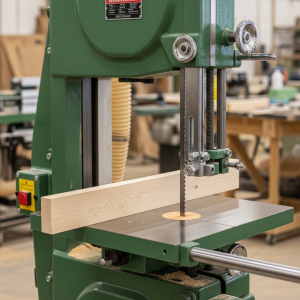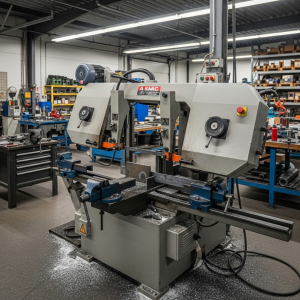Vertical vs Horizontal Band Saw: Key Differences, Benefits, and Best Uses
If you’ve ever browsed for cutting equipment, you’ve probably faced the vertical vs horizontal band saw decision. While both machines fall under the “band saw” category, they function differently and excel in different situations. The right choice depends on the type of material you’re working with, the shapes you need to cut, and the efficiency you require. This article breaks down the distinctions, advantages, and ideal uses of each to help you make the best choice for your shop or business.
Understanding the Vertical Band Saw

A vertical band saw has a blade running in an upright position between two wheels, moving in a continuous loop. In this design, the operator manually pushes the material against the blade, giving complete control over the cutting process. This makes it perfect for intricate cuts, patterns, and custom designs.
Why people choose vertical band saws:
- Excellent for curved and angled cuts.
- Handles wood, metal, and plastics with the right blade.
- Offers more creative freedom for custom shapes.
Vertical band saws are particularly popular in woodworking shops, metal fabrication facilities, and even art studios where precision and flexibility are top priorities.
Understanding the Horizontal Band Saw

In a horizontal band saw, the blade is mounted on a horizontal arm that moves down through the material. The workpiece remains stationary while the blade does the movement. This setup is ideal for cutting through thick stock and producing straight, accurate cuts with minimal manual effort.
Why people choose horizontal band saws:
- Perfect for large, heavy materials.
- Produces consistent, repeatable cuts.
- Can be automated for higher production rates.
These saws are widely used in industrial settings where speed, productivity, and uniformity are essential.
Key Differences at a Glance
- Cutting Style
- Vertical: Operator-controlled, great for complex shapes.
- Horizontal: Machine-controlled, perfect for straight cuts.
- Material Handling
- Vertical: Material moves toward the blade.
- Horizontal: Blade moves through stationary material.
- Best Fit
- Vertical: Custom fabrication, artistic designs, detailed work.
- Horizontal: High-volume stock cutting, industrial applications.
- Efficiency
- Vertical: Slower for large cuts but more versatile.
- Horizontal: Fast for repetitive tasks but limited in design flexibility.
Benefits of the Vertical Band Saw
- Versatility – Cuts curves, angles, and detailed patterns in various materials.
- Precision – Manual control offers greater accuracy for creative work.
- Space Saving – Often more compact, fitting well into small shops.
Benefits of the Horizontal Band Saw
- Productivity – Quickly cuts large batches of material.
- Consistency – Delivers uniform cuts, reducing waste.
- Ease of Use – Minimal manual handling, especially with automated feeds.
Best Uses for Each Type
Vertical Band Saw:
- Furniture making and cabinetry.
- Shaping metal brackets or artistic metal pieces.
- Cutting prototypes from wood, plastic, or composite boards.
Horizontal Band Saw:
- Cutting steel beams, aluminum billets, or PVC pipes.
- Preparing bar stock for machining.
- Repetitive, high-volume production work.
How to Choose Between Them
When choosing between a vertical vs horizontal band saw, think about your primary cutting needs:
- Go vertical if you require creativity, flexibility, and the ability to handle various materials and shapes.
- Go horizontal if you work with large materials and value speed and consistency over complex cutting.
Some businesses use both, taking advantage of each machine’s strengths to handle different types of work efficiently.
Selecting between a vertical vs horizontal band saw is all about matching the tool to the job. The vertical saw thrives in creative, detail-oriented projects, while the horizontal saw excels in heavy-duty, high-output environments. Whichever you choose, investing in quality equipment ensures safety, accuracy, and long-term reliability. For durable, high-performance band saws and industrial solutions, Can Star Industrial offers trusted products designed to meet the needs of both small workshops and large-scale production facilities.
